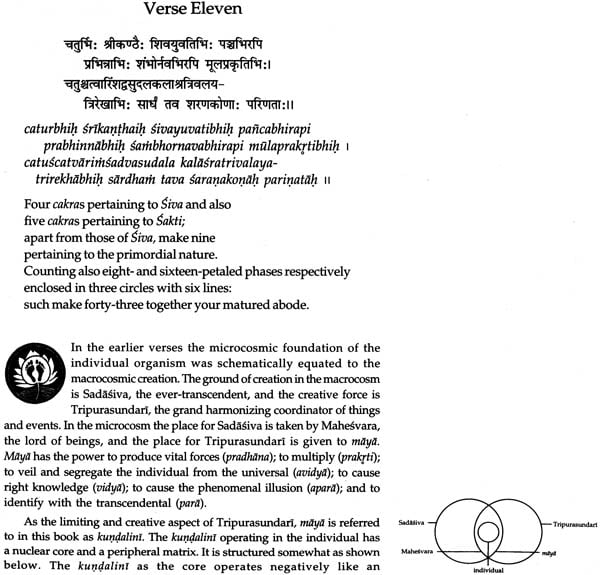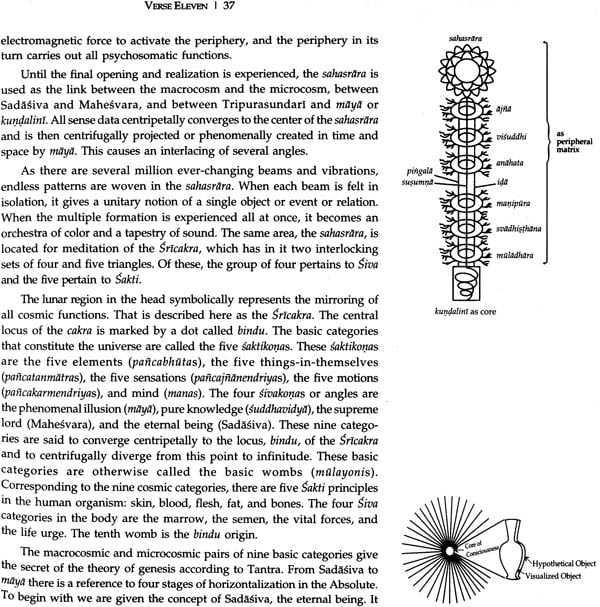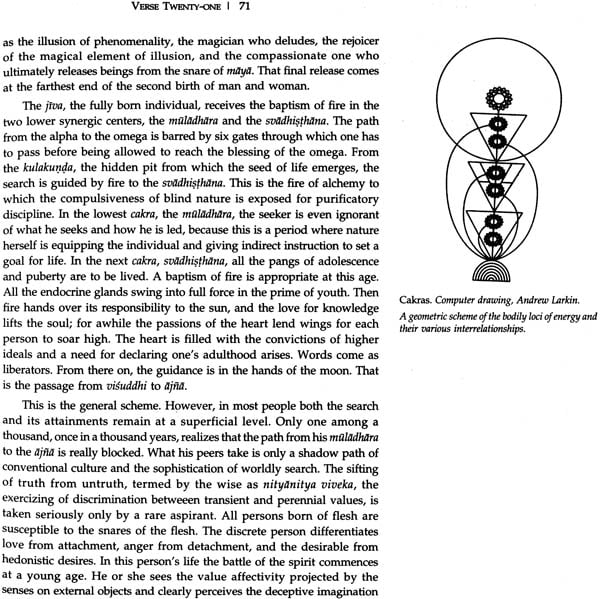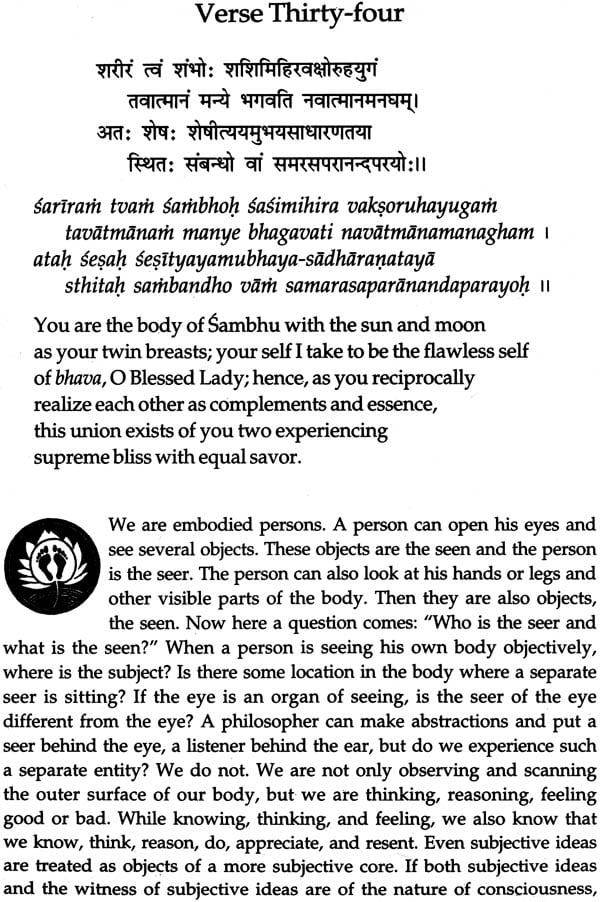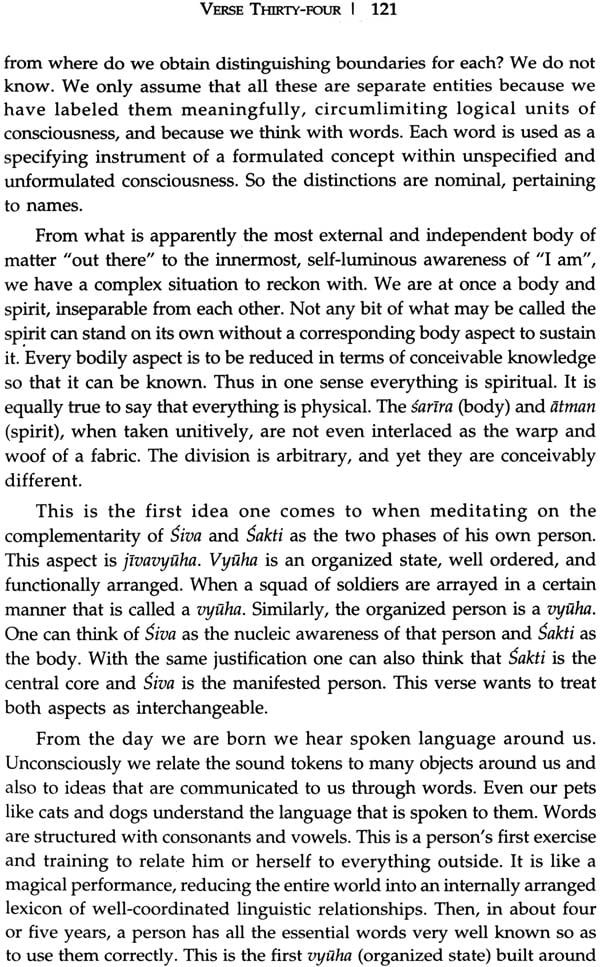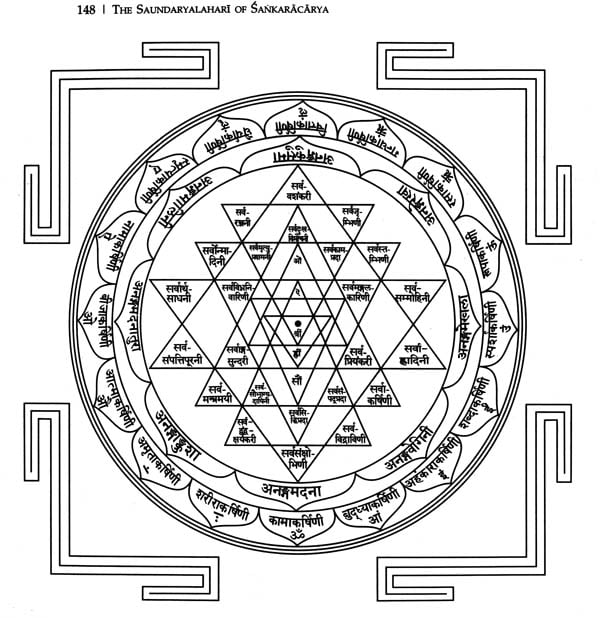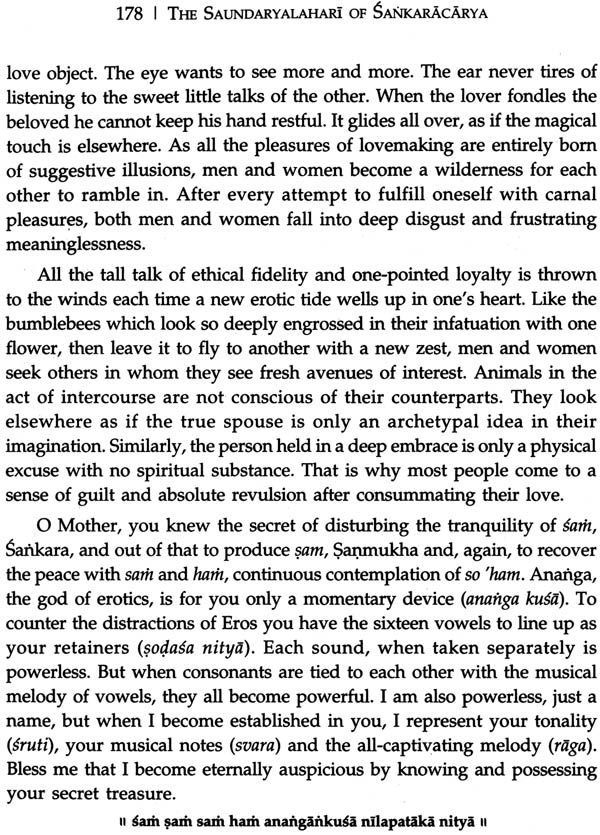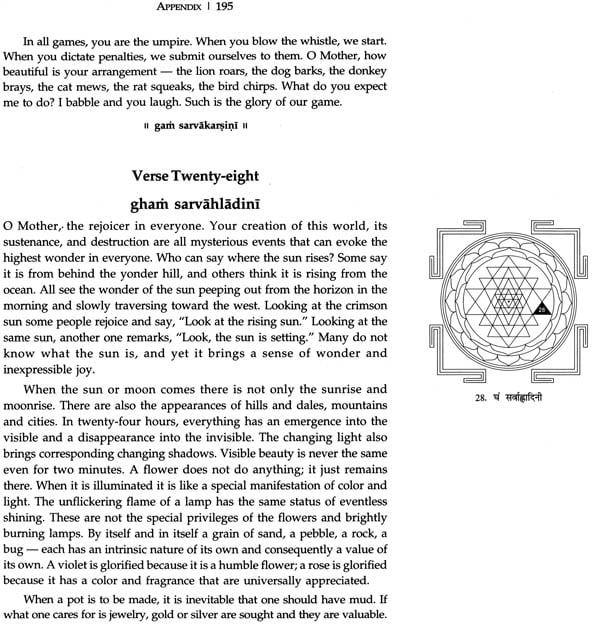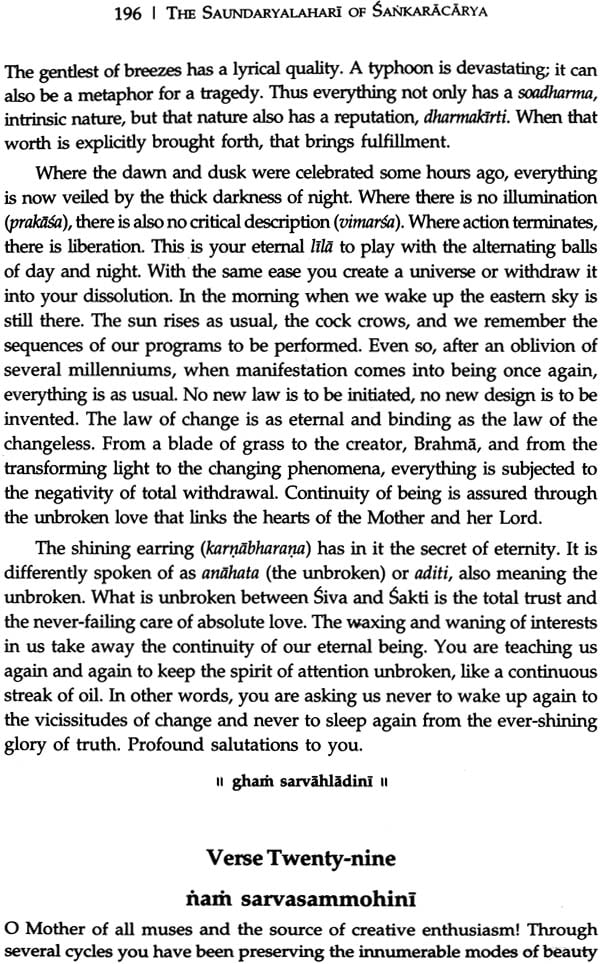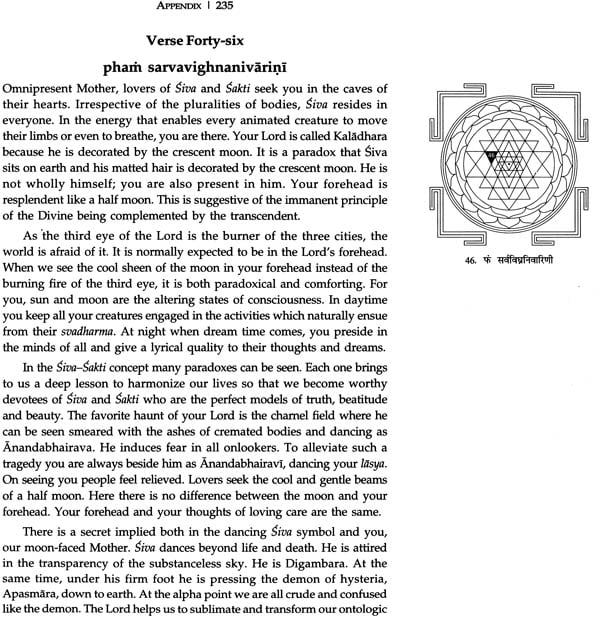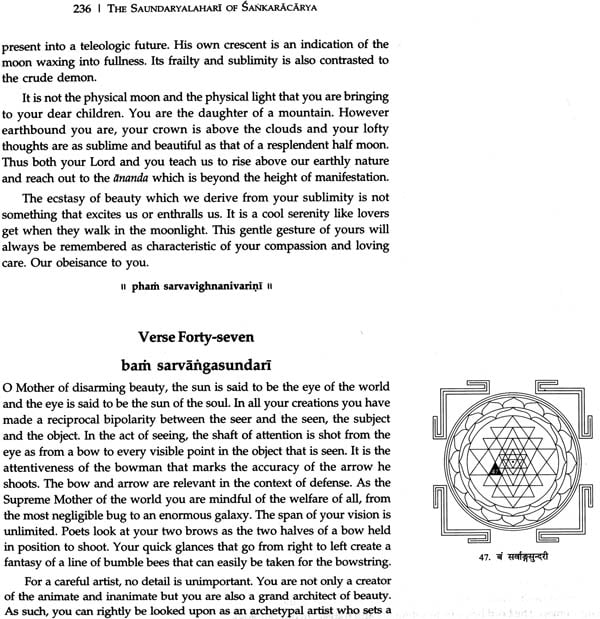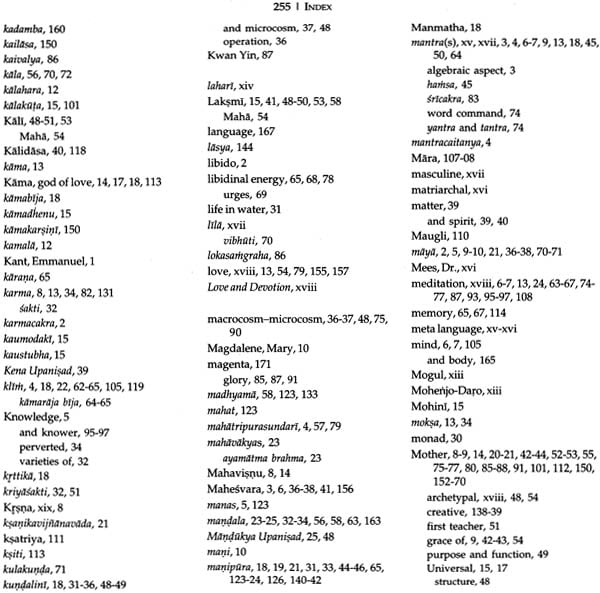
The Saundaryalahari of Sankaracarya (A Translation and Commentary on the Anandalahari)
Book Specification
| Item Code: | NAL488 |
| Author: | Nitya Chaitanya Yati |
| Publisher: | D. K. Printworld Pvt. Ltd. |
| Language: | Sanskrit Text With Transliteration and English Translation |
| Edition: | 2015 |
| ISBN: | 9788124608104 |
| Pages: | 220 (146 B/W Illustrations) |
| Cover: | Hardcover |
| Other Details | 10.0 inch x 10.0 in |
| Weight | 1 kg |
Book Description
This book comprises the first part of Saundarya Lahari (The Upsurging Billow of Beauty), popularly known Ananda Lahari, covering the first forty-one verses.
This poetic work has fascinated generations of scholars and layperson with the sublime beauty of the verses in praise of the Devi, but also puzzled people by the authorship of Sankara. The text is a protolinguistic composition using a pictorial language of images. Beauty, elevated to the highest level, provides content to the otherwise abstract notion of the Absolute. The absolute joy of Advaita is presented subjectively as ananda and objectively as saundarya.
This tenth-century hymn to the Devi is a poetic restatement by the philosopher Sankara of his strict Advaita Vedanta monism. In compelling series of verses, Sankara draws in many strands of India’s heritage and braids them into a vision of luminous, transcendent Beauty.
The present commentary by Guru Nitya Chaitanya Yati grew out of his class of intimate meditations. He has integrated the academic disciplines of aesthetics, linguistics, and psychology with contemplation into a comprehensive study of creative manifestation. The heterodox Tantric Sri Vidya schools are centered on the realistic worship of the Devi Goddess and the Sri Cakra. Keeping in line with contemplation, the Appendix provides 53 meditations on the Sri Cakra.
Guru Nitya Chaitanya Yati (1923-1999) was born into a family of scholars and poets in Kerala Stath India. He was in the spiritual hierarchy of the mystic Narayana Guru and was a direct disciple of Nataraja Guru, who founded the Narayana Gurukula, a worldwide contemplative fraternity, and the East West Universe of Brahmavidya. In his youth Guru Nitya spent several years as wandering mendicant, studying with traditional teachers from a variety of spiritual traditions. As a scholar of philosophy and psychology, Guru Nitya had been a professor at colleges throughout India; in addition he had travelled and taught in Europe, Australia and America. While specializing in India’s inheritance of wisdom, he was full versed in modern academic thinking as well, with special emphasis on the field of psychology. His contemplative absorption gave him the grace of mystical envisioning.
Within the historical panorama of Bharata, or Greater India, numerous philosophical and religious traditions have flourished and over the centuries many of these strands have intermingled, creating a dense and rich cultural horizon. Emerging from this background is the Saundaryalahari; a Sanskrit poem of 100 verses, it is a work both vital and enigmatic. The Saundaryalahari is claimed as an essential text by the Tantric Srividya schools, a heterodox form of Hindu worship centered on the Devi, or goddess. At the same time, it is also considered to be one of the final works of the ninth-century philosopher Sankaracarya, staunchest proponent of Advaita Vedanta (non-dual monism). The position that the Saundaryalahari occupies between these two often contradictory traditions highlights essential characteristics of the history of Indian philosophy and of the poem itself.
From the prehistoric Indus Valley culture of Mohenjo-Daro through its conquest by the Aryans, the incursions of Central Asian nomads, Arab traders, and finally to Mogul conquest and European colonization, Indian cultural development has relied upon recurring revaluations of earlier thought in the light of challenging new interactions. Each era has remolded its philosophical inheritance to its own necessities. When Sankara was wandering throughout India as mendicant teacher and writing his vast, erudite commentaries on the Upanisads, the major factoer on the cultural field were:
. a degenerate Hinduism that was both exaggerated and divided;
. the proliferation of heterodox practices under the umbrella of this degeneration;
.a strong challenge to Hinduism by intellectually spare, reform-minded Buddhism;
.and the expansion of south India Kingdoms and culture into South-East Asia, coupled with the cosmopolitan urbanity of the
Malabar Coast (home to Sankara) where Christian, Christian, Chinese, and Indian traditions converged along trade routes.
Upon this multivalent stage, Sankara began his bhasyas (commentaries). In these and in has famous debates with Buddhist philosophers, Sankara resurrected and reinvigorated the essential philosophical insights of the early Upanisadic rsis. The Upanisads present uncompromising vision of unified Beingness which is seamless, without division in time or space, and which sustains all the variegated individualities we relate to in our transactional lives. It is this world-view that Sankara restated in a form unembellished by religious dogma.
Numerous schools flourished at this time and they practiced a spirituality which consciously contradicted all the strictures of a classist, authoritarian Brahminism. Debate and rebuttal had been Sankara’s procedure with a distorted Hinduism and its rival Buddhism. With Tantra the revaluation was more subtle. A deep veneration for the primal energy of manifestation, sakti, often personified as the goddess or Devi, is the potent nucleus of Tantra that Sankara extricated from its ritualistic encrustations. In his two final works, the Saundaryalahari and the Sivanandalahari, Sankara used Tantra’s intense and intimate identification with feminine nature to sculpt his poetic presentation of essential Upanisadic truth. In the Saundaryalahari, he draws on the deepest of Indian traditions, its Dravidian contemplative culture (often thought to be the prehistoric source of Tantric practice), to restate in a refined manner the same spare insights of his Advaita commentaries. By drawing in and sublimating the devotional and heterodox currents of his time, Sankara enriches the strict purity of his philosophy.
The Sundaryalahari is divided into two, sometimes three, distinct sections. The first forty–one verses are the Anandalahari, often separately published, as is done here, and considered the most important section of the book. The second section consists of verses 42 through 100; verses 92 through 100 are sometimes grouped as a third section. Together these sections comprise the Saundaryalahari. Lahari translates intoxication or “an overwhelming subjective or objective experience of an item of intelligence or of beauty upsurging in the mind of man” (Nataraja Guru). The factor of intoxication or flooding or flooding of consciousness is present throughout all sections of the book. In the first forty-one verses, ananda is used in the of delight or bliss and refers to that experience of value which is subjectively appreciated. Saundarya refers to beauty, to an aesthetic value appreciation which is objective. Taken together, ananda (delight) and saundarya (beauty) constitute an overwhelming, intoxicating experience which is subjective and objective, inward and outward, one that permeates consciousness and allows a person to participate in the continuous pulsation of the neutral Absolute into magnetic, compelling manifestation of Beauty.
In the last 1,200 years, there have been innumerable publications of the Saundaryalahari in India, some with commentaries, some with accompanying paintings of the goddess, many with a variety of mantras or yantras for each of the verses. It has continued to be used as devotional text, its verses chanted and meditated upon. However, until 1958 when the Harvard Oriental Series edition by Professor Norman Brown was published, there had been only two publication of the Saundaryalahari in any European language. Brown’s translation and comments are well grounded in an honest, thoughtful appreciation of the They falter, however, on his too cautious, academic literalism, and very little of the Saundaryalahari’s poetic or mystical tenor is allowed to come forth.
In 1988 an English translation commentary by Nataraja Guru was published by East-West University in India. Nataraja Guru brought to bear on his study of the Saundaryalahari a philosophical vision steeped in the multiple cross-currents that were formed by the intersection of Indian tradition and the disciplines of modern Western science. The son of a prominent social reformer of south India, Nataraja Guru received his first degrees in zoology and geology. He went on to a D.Litt. in educational philosophy at the Sorbonne in Paris, later teaching at Quaker school in Geneva, Switzerland. This varied background nurtured in him an ability to analyze beneath surface appearance to structural foundations and to look for interdisciplinary coherence.
According to the traditional psychology of Vedanta, the Absolute is conceived both as the transcendental para and the immanent apara. In slightly modified sense, Tantra calls these Siva and Sakti, respectively. There are mythological stories describing Siva as the destroyer of the three cities, Tripurantaka, a city (pura) being a multi-structured matrix of human interest. These there of man;s interests are the worlds of the cosmos, of ethos or social culture, and of the psyche.
Man is interested in the cosmic phenomena to which his place of habitation, the green earth, belongs. In the city of the cosmos he has the starry heavens that conceal within themselves system upon system, from the nebular to the biological. Within the system of his own solar orbit, man relates the events of his life to the rotations of the planets, the waxing and waning of the moon, the equinoxes of the sun, the change of the seasons, the sea, and the cyclones and earthquakes which expose him to the caprice of fateful chance. Man’s city of the cosmos ranges from the glistening dew drops on the rose in his garden to the infinite that stretches far beyond the farthest star which has not yet kissed the earth with its beams of light. This city is full of awe, enormous and sublime. By its quantitative or qualitative might, this cosmos shocks man and fills him with pain at his own smallness, then fills him with a feeling of exaltation at the greatness of his own moral nature, which is “loftier than all the splendors of the outer world” (Immanuel Kant). The second city of man is the “moral world below” which is festooned with smiles and tears. It is here man lives with his fellow men and women in love and hatred, where he marries and begets children, and husbands land and rears cattle. It is here that he trades with all that can be purchased and sold, including war and peace, and morality and justice. Sociology and commerce, economics and politics are the pastimes of this city. Here man erects school and legislative houses, jail and concentration camps, temples of god, and art emporiums. He revels here in his operas and theatres. From this city man shoots his missiles to the distant planets. He performs impossible feats in medicine feats in medicine and surgery to save rare human life, and then with the same ease of conscience plugs in the wires of electric chairs to wipe out those whom he fears. Man lives in this second city called samsara weaving tales of fret and fume signifying and seeing visions of beauty, truth, and goodness.
Man’s third city lies in the crevice of his brain and in the cave of his heart. It is the realm of his psyche. The face of this city is man’s surface consciousness that changes its hues from the pink rose of morning’s glory to the terrifying dark of dreadful night. It is in this world that man becomes erotic or sarcastic, compassionate or destructive, heroic or frightful. Mysteries and marvels of the unknown fill this city with wonder or fear that ever remain a secret to man. It is in this innermost city that man listens to the call of the Absolute and longs for liberation. It is just here that he receives the all-consuming light of the third eye of Siva, the burner of the three cities, the Tripurantaka.
Siva sets ablaze the spark of individual consciousness into an all-devouring conflagration, which ultimately burns away Time and Space and all the phenomenal names and forms that give content and structure to the three cities of the cosmos (brahmanda), politikos (samsara), and psychos (ahamkara). The counterpart of Tripurantaka is Tripurasundari, the beauty that bathes the above-said three cities of man with her eternal glory and veiling maya. In all the three cities, the city of the heavenly galaxy and nature, the city of interpersonal relationships, and the city of the libido and subliminal psychic underworld, man stands spellbound by the beauty of Tripurasundari. He is enlightened by the truth of her wisdom. He is inspired by her never-failing law, her ingenious sense of structure, and her unsurpassed goodness. In the eastern skies of the unchanging Siva, Tripurasundari paints in gold and purple the dawn of creation. In his midday skies she sets the clock of action, Karma cakra, which keeps the wheel of samsara whirling into cyclic rhythms. In his evening skies she paints the dissolution of all that vanishes behind the crimson veil of the dying sun.
| Acknowledgment | vii |
| Guide to Sanskrit Pronunciation | vii |
| Foreword | xiii |
| Photographic Credits | xx |
| Introduction | 1 |
| Verse One | 3 |
| Verse Two | 6 |
| Verse Three | 8 |
| Verse Four | 12 |
| Verse Five | 14 |
| Verse Six | 17 |
| Verse Seven | 20 |
| Verse Eight | 23 |
| Verse Nine | 27 |
| Verse Ten | 33 |
| Verse Eleven | 36 |
| Verse Twelve | 39 |
| Verse Thirteen | 42 |
| Verse Fourteen | 44 |
| Verse Fifteen | 48 |
| Verse Sixteen | 52 |
| Verse Seventeen | 55 |
| Verse Eighteen | 60 |
| Verse Nineteen | 63 |
| Verse Twenty | 67 |
| Verse Twenty-one | 70 |
| Verse Twenty-two | 73 |
| Verse Twenty-three | 85 |
| Verse Twenty-four | 88 |
| Verse Twenty-five | 92 |
| Verse Twenty-six | 95 |
| Verse Twenty-seven | 98 |
| Verse Twenty-eight | 101 |
| Verse Twenty-nine | 104 |
| Verse Thirty | 107 |
| Verse Thirty-one | 109 |
| Verse Thirty-two | 112 |
| Verse Thirty-three | 116 |
| Verse Thirty-four | 120 |
| Verse Thirty-five | 124 |
| Verse Thirty-six | 127 |
| Verse Thirty-seven | 131 |
| Verse Thirty-eight | 134 |
| Verse Thirty-nine | 137 |
| Verse Forty | 140 |
| Verse Forty-one | 143 |
| Appendix: Meditation on Sricakra | 147 |
| Verse One | 152 |
| Verse Two | 153 |
| Verse Three | 155 |
| Verse Four | 156 |
| Verse Five | 158 |
| Verse Six | 159 |
| Verse Seven | 160 |
| Verse Eight | 161 |
| Verse Nine | 162 |
| Verse Ten | 163 |
| Verse Eleven | 165 |
| Verse Twelve | 166 |
| Verse Thirteen | 167 |
| Verse Fourteen | 168 |
| Verse Fifteen | 170 |
| Verse Sixteen | 172 |
| Verse Seventeen | 174 |
| Verse Eighteen | 177 |
| Verse Nineteen | 179 |
| Verse Twenty | 180 |
| Verse Twenty-one | 182 |
| Verse Twenty-two | 184 |
| Verse Twenty-three | 186 |
| Verse Twenty-four | 188 |
| Verse Twenty-five | 190 |
| Verse Twenty-six | 192 |
| Verse Twenty-seven | 193 |
| Verse Twenty-eight | 195 |
| Verse Twenty-nine | 196 |
| Verse Thirty | 198 |
| Verse Twenty-one | 201 |
| Verse Twenty-two | 204 |
| Verse Twenty-three | 207 |
| Verse Twenty-four | 209 |
| Verse Twenty-five | 212 |
| Verse Twenty-six | 214 |
| Verse Twenty-seven | 216 |
| Verse Twenty-eight | 219 |
| Verse Twenty-nine | 220 |
| Verse Forty | 222 |
| Verse Forty-one | 224 |
| Verse Forty-Two | 226 |
| Verse Forty-three | 228 |
| Verse Forty-four | 229 |
| Verse Forty-five | 231 |
| Verse Forty-six | 235 |
| Verse Forty-seven | 236 |
| Verse Forty-eight | 238 |
| Verse Forty-nine | 240 |
| Verse fifty | 242 |
| Verse Fifty-one | 244 |
| Verse Fifty-two | 247 |
| Verse Fifty-three | 250 |
| Index | 252 |
